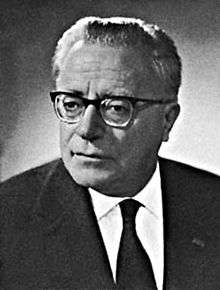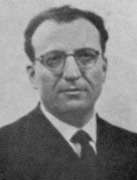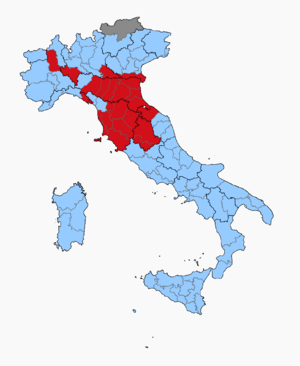Italian general election, 1948
| | |||||||||||||||||||||||||||||||||||||||||||||||||||||||||||||||
| |||||||||||||||||||||||||||||||||||||||||||||||||||||||||||||||
| |||||||||||||||||||||||||||||||||||||||||||||||||||||||||||||||
|
| |||||||||||||||||||||||||||||||||||||||||||||||||||||||||||||||
| Legislative election results map: Light Blue denotes provinces with a Christian Democratic plurality, Red a Frontist plurality, and Gray an Autonomist plurality. | |||||||||||||||||||||||||||||||||||||||||||||||||||||||||||||||
| |||||||||||||||||||||||||||||||||||||||||||||||||||||||||||||||
General elections were held in Italy on Sunday 18 April 1948 to elect the First Republican Parliament.[2] They were heavily influenced by the Cold War confrontation between the Soviet Union and the United States. After the communist coup in Czechoslovakia in February 1948, the US became alarmed about Soviet intentions and feared that, if the leftist coalition were to win the elections, the communist Left would draw Italy into the Soviet Union's sphere of influence. As the last month of the election campaign began, the magazine Time pronounced the possible leftist victory to be "the brink of catastrophe".[3]
The elections were eventually won with a comfortable margin by the Christian Democracy party (Italian: Democrazia Cristiana, DC) that defeated the left-wing coalition of the Popular Democratic Front (Italian: Fronte Democratico Popolare per la libertà, la pace, il lavoro, FDP) that comprised the Italian Communist Party (Italian: Partito Comunista Italiano, PCI) and the Italian Socialist Party (Italian: Partito Socialista Italiano, PSI).
The Christian Democrats went on to form a government without the Communists, who had been in government from June 1944, when the first post-war government was formed, until May 1947.
Electoral system
The pure party-list proportional representation chosen two years before for the election of the Constituent Assembly, was definitely adopted for the Chamber of Deputies. Italian provinces were divided into 31 constituencies, each electing a group of candidates.[4] In each constituency, seats were divided between open lists using the largest remainder method with the Imperiali quota. Remaining votes and seats transferred to the national level, where special closed lists of national leaders received the last seats using the Hare quota.
For the Senate, 237 single-seat constituencies were created. The candidates needed a two-thirds majority to be elected, but only 15 aspiring senators were elected this way. All remaining votes and seats were grouped in party lists and regional constituencies, where the D'Hondt method was used: Inside the lists, candidates with the best percentages were elected.
This electoral system became standard in Italy, and was used until 1993.
Campaign
The elections remain unmatched in verbal aggression and fanaticism in Italy's period of democracy. According to the historian Gianni Corbi the 1948 election was "the most passionate, the most important, the longest, the dirtiest, and the most uncertain electoral campaign in Italian history".[5] The election was between two competing visions of the future of Italian society. On the one hand, a Roman Catholic, conservative and capitalist Italy, represented by the governing Christian Democrats of De Gasperi; on the other, a secular, revolutionary and socialist society, represented by the Popular Front.[5]
The Christian Democrat campaign claimed that in communist countries, "children send parents to jail", "children are owned by the state", "people eat their own children", and assured voters that disaster would strike Italy if the Left were to take power.[6][7] Another slogan was "In the secrecy of the polling booth, God sees you - Stalin doesn't."[8]
The PCI was de facto leading the FDP and had effectively marginalised the PSI, which thus eventually suffered because in the elections, in terms of parliamentary seats and political power;[9] The Socialists also had been hurt by the secession of a social-democratic faction led by Giuseppe Saragat, which contested the election with the concurrent list of Socialist Unity.
The PCI had difficulties in restraining its more militant members, who, in the period immediately after the war, had engaged in violent acts of reprisals. The areas affected by the violence (the so-called "Red Triangle" of Emilia, or parts of Liguria around Genoa and Savona, for instance) had previously seen episodes of brutality committed by the Fascists during Benito Mussolini's regime and the Italian Resistance during the Allies' gradual advance through Italy.
Superpower influence
The 1948 general election was greatly influenced by the Cold War that was starting between the United States and the Soviet Union.[10]
The CIA, by its own admission, gave $1 million to Italian "center parties".[11] and was accused of publishing forged letters in order to discredit the leaders of the Italian Communist Party.[12] The National Security Act of 1947, that made foreign covert operations possible, had been signed into law about six months earlier by the American President Harry S. Truman.
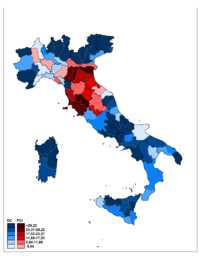
"We had bags of money that we delivered to selected politicians, to defray their political expenses, their campaign expenses, for posters, for pamphlets," according to CIA operative F. Mark Wyatt.[13] In order to influence the election, the US agencies undertook a campaign of writing ten million letters, made numerous short-wave radio broadcasts and funded the publishing of books and articles, all of which warned the Italians of what was believed to be the consequences of a communist victory. Time Magazine backed the campaign and featured the Christian Democrat leader and Prime Minister Alcide De Gasperi on its cover and in its lead story on 19 April 1948.[7]
The PCI was being funded by the Soviet Union.[14] According to Wyatt. "The Communist Party of Italy was funded ... by black bags of money directly out of the Soviet compound in Rome; and the Italian services were aware of this. As the elections approached, the amounts grew, and the estimates [are] that $8 million to $10 million a month actually went into the coffers of communism. Not necessarily completely to the party: Mr. Di Vittorio and labor was powerful, and certainly a lot went to him," according to the former CIA operative.[12] Although the numbers are disputed, there is evidence of some financial aid, described as occasional and modest,[15] from the Kremlin.[16] PCI official Pietro Secchia and Stalin discussed financial support.[17]
The Christian Democrats eventually won the 1948 election with 48% of the vote, and the FDP received 31%. The CIA's practice of influencing the political situation was repeated in every Italian election for at least the next 24 years.[13] A leftist coalition would not win a general election for the next 48 years, until 1996. That was partly because of Italians' traditional bent for conservatism and, even more importantly, the Cold War, with the US closely watching Italy, in their determination to maintain a vital NATO presence amidst the Mediterranean and retain the Yalta-agreed status quo of western Europe.[18]
Parties and leaders
| Party | Ideology | Leader | |
|---|---|---|---|
| Christian Democracy (DC) | Christian democracy, Popularism | Alcide De Gasperi | |
| Popular Democratic Front (FDP) | Communism, Socialism | Palmiro Togliatti, Pietro Nenni | |
| Socialist Unity (US) | Social democracy, Socialism | Ivan Matteo Lombardo | |
| National Bloc (BN) | Liberalism, Conservatism | Leone Cattani | |
| Monarchist National Party (PNM) | Monarchism, Conservatism | Alfredo Covelli | |
| Italian Republican Party (PRI) | Republicanism, Social liberalism | Randolfo Pacciardi | |
| Italian Social Movement (MSI) | Neo-Fascism, Italian nationalism | Giorgio Almirante | |
Results
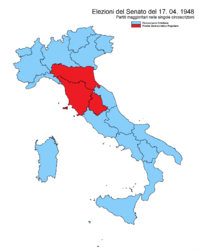
Christian Democracy won a sweeping victory, taking 48.5 percent of the vote and 305 seats in the Chamber of Deputies and 131 seats in the Senate. With an absolute majority in both chambers, DC leader and premier Alcide De Gasperi could have formed an exclusively DC government. Instead, he formed a "centrist" coalition with Liberals, Republicans and Social Democrats. De Gasperi formed three Councils of Ministers, the second one in 1950 after the defection of the Liberals, who hoped for more rightist politics, and the third one in 1951 after the defection of the Social-democrats, who hoped for more leftist politics.
Following a provision of the new Constitution of Italy, all living democratic deputies elected during the 1924 general election and deposed by the National Fascist Party in 1926, automatically became members of the first republican Senate.
Chamber of Deputies
 | |||||
| Party | Votes | % | Seats | +/− | |
|---|---|---|---|---|---|
| Christian Democracy | 12,740,042 | 48.51 | 305 | +98 | |
| Popular Democratic Front | 8,136,637 | 30.98 | 183 | −36 | |
| Socialist Unity | 1,858,116 | 7.07 | 33 | New | |
| National Bloc | 1,003,727 | 3.82 | 19 | −52 | |
| Monarchist National Party | 729,078 | 2.78 | 14 | −2 | |
| Italian Republican Party | 651,875 | 2.48 | 9 | −14 | |
| Italian Social Movement | 526,882 | 2.01 | 6 | New | |
| South Tyrolean People's Party | 124,243 | 0.47 | 3 | New | |
| Party of Italian Peasants | 95,914 | 0.37 | 1 | ±0 | |
| Social Christian Party | 72,854 | 0.28 | 0 | ±0 | |
| Sardinian Action Party | 61,928 | 0.24 | 1 | −1 | |
| Nationalist Movement for the Social Democracy | 56,096 | 0.21 | 0 | New | |
| Federalist Movements' Union | 52,655 | 0.20 | 0 | New | |
| Unionist People's Bloc | 35,899 | 0.14 | 0 | New | |
| Others | 118,512 | 0.44 | 0 | ±0 | |
| Invalid/blank votes | 591,283 | – | – | – | |
| Total | 26,855,741 | 100 | 574 | +18 | |
| Registered voters/turnout | 29,117,270 | 92.23 | – | – | |
| Source: Ministry of the Interior | |||||
Senate of the Republic
 | |||||
| Party | Votes | % | Seats | ||
|---|---|---|---|---|---|
| Christian Democracy | 10,899,640 | 48.11 | 131 | ||
| Popular Democratic Front | 6,969,122 | 30.76 | 72 | ||
| National Bloc | 1,222,419 | 5.40 | 7 | ||
| Socialist Unity | 943,219 | 4.16 | 8 | ||
| Socialist Unity–PRI | 607,792 | 2.68 | 4 | ||
| Italian Republican Party | 594,178 | 2.62 | 4 | ||
| Monarchist National Party | 393,510 | 1.74 | 3 | ||
| Italian Social Movement | 164,092 | 0.72 | 1 | ||
| South Tyrolean People's Party | 94,406 | 0.42 | 2 | ||
| Party of Italian Peasants | 65,986 | 0.29 | 0 | ||
| Sardinian Action Party | 65,743 | 0.29 | 0 | ||
| Federalist Movements' Union | 42,880 | 0.19 | 0 | ||
| Nationalist Movement for the Social Democracy | 27,152 | 0.12 | 0 | ||
| Others | 22,108 | 0.10 | 0 | ||
| Independents | 544,039 | 2.40 | 4 | ||
| Invalid/blank votes | 1,185,629 | – | – | ||
| Total | 23,842,919 | 100 | 237 | ||
| Registered voters/turnout | 25,874,809 | 92.15 | – | ||
| Source: Ministry of the Interior | |||||
References
- ↑ Direct confrontation being impossible cause the split of former socialist PSIUP party between the revolutionary PSI and the social-democratic PSDI in 1947, unofficial swing was calculated using the strength ratio (65:50) between the socialist group and the social-democratic group in Parliament after the division.
- ↑ Nohlen, D & Stöver, P (2010) Elections in Europe: A data handbook, p1048 ISBN 978-3-8329-5609-7
- ↑ Fateful Day, Time Magazine, March 22, 1948
- ↑ The number of seats for each constituency went from 1 for Aosta Valley to 36 for Milan.
- 1 2 Ventresca, From Fascism to Democracy, p. 4
- ↑ "Show of Force", TIME Magazine, April 12, 1948
- 1 2 "How to Hang On", TIME Magazine, April 19, 1948
- ↑ "Fertility vote galvanises Vatican", BBC News, 13 June 2005
- ↑ The Communist party gained more than the two-thirds of the seats won by the joint list. ("Number of MPs for each political group during the First Legislature", Italian Chamber of Deputies website.
- ↑ Brogi, Confronting America, pp. 101-110
- ↑ CIA memorandum to the Forty Committee (National Security Council), presented to the Select Committee on Intelligence, United States House of Representatives (the Pike Committee) during closed hearings held in 1975. The bulk of the committee's report that contained the memorandum was leaked to the press in February 1976 and first appeared in book form as CIA – The Pike Report (Nottingham, England, 1977). The memorandum appears on pp. 204-5 of this book.
- 1 2 "CNN Cold War Episode 3: Marshall Plan. Interview with F. Mark Wyatt, former CIA operative in Italy during the election.". CNN.com. 1998–1999. Archived from the original on August 31, 2001. Retrieved 2006-07-17.
- 1 2 F. Mark Wyatt, 86, C.I.A. Officer, Is Dead, The New York Times, July 6, 2006
- ↑ Brogi, Confronting America, p. 109
- ↑ Ventresca, From Fascism to Democracy, p. 269
- ↑ Callanan, Covert Action in the Cold War, pp. 41-45
- ↑ Pons, Silvio (2001), Stalin, Togliatti, and the Origins of the Cold War in Europe, Journal of Cold War Studies, Volume 3, Number 2, Spring 2001, pp. 3-27
- ↑ "N.A.T.O. Gladio, and the strategy of tension". Chapter from “NATO’s Secret Armies. Operation Gladio and Terrorism in Western Europe”, by daniele Ganser. October 2005. Retrieved 2006-07-21.
- Brogi, Alessandro (2011). Confronting America: The Cold War Between the United States and the Communists in France and Italy, Chapel Hill: University of North Carolina Press, ISBN 978-0-8078-3473-2
- Callanan, James (2010). Covert Action in the Cold War: US Policy, Intelligence and CIA Operations, London/New York: I.B. Tauris, ISBN 978-1-84511-882-2
- Ventresca, Robert A. (2004). From Fascism to Democracy: Culture and Politics in the Italian Election of 1948, Toronto: University of Toronto Press, ISBN 0-8020-8768-X
Further reading
- Blum, William (2000). Killing Hope. Common Courage Press. ISBN 978-1-56751-053-9. Chapter 2 Italy 1947-1948: Free elections: Hollywood style
- Blum, William (2000). Rogue State: A Guide to the World's Only Superpower. Common Courage Press. ISBN 978-1-56751-194-9. Chapter 16 Perverting elections
| Wikimedia Commons has media related to Italian general election, 1948. |

